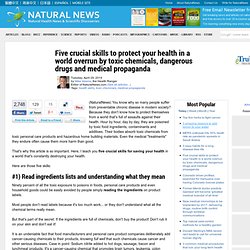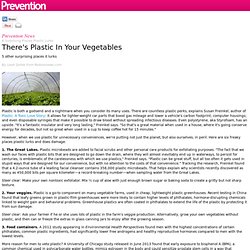

5 Tips For a Non-Toxic Lifestyle. Want to live a healthier and cleaner life?

It's easier than you think... 1. Buy organic. Significantly reduced synthetic chemicals plus more nutrients! Healthy plants and animals will help you be healthy too. 2. 3. 4. 5. Following these 5 basic guidelines will help decrease your toxin exposure while also supporting healthy detoxification pathways in your body. 5 Tips For a Non-Toxic Lifestyle.
Five crucial skills to protect your health in a world overrun by toxic chemicals, dangerous drugs and medical propaganda. (NaturalNews) You know why so many people suffer from preventable chronic disease in modern society?

Because they don't know how to protect themselves from a world that's full of assaults against their health. Hour by hour, day by day, they are poisoned by toxic food ingredients, contaminants and additives. Their bodies absorb toxic chemicals from toxic personal care products and hazardous home building materials. Even the medical "treatments" they endure often cause them more harm than good. That's why this article is so important.
Here are those five skills: Ninety percent of all the toxic exposure to poisons in foods, personal care products and even household goods could be easily avoided by people simply reading the ingredients on product labels. Most people don't read labels because it's too much work... or they don't understand what all the chemical terms really mean.
Detox. Fluoride. Top 4 ways to improve liver function. 6 Surprising Places Plastic Lurks. Plastic is both a godsend and a nightmare when you consider its many uses.

There are countless plastic perks, explains Susan Freinkel, author of Plastic: A Toxic Love Story: it allows for lighter-weight car parts that boost gas mileage and lower a vehicle's carbon footprint; computer housings; and even disposable syringes that make it possible to draw blood without spreading infectious diseases. Even polystyrene, aka Styrofoam, has an upside. "It's a fantastic insulator and very long lasting," Freinkel says. "So that's a great material when used in a house, where it's going conserve energy for decades, but not so great when used in a cup to keep coffee hot for 15 minutes. " How To Shield Yourself From Computer & Cell Phone Radiation. Ok, so you’re sitting at your computer, reading this article (and I’m really, really glad you are, so do keep reading).

However, your computer screen, at this very moment, is bathing you in the warm glow of electromagnetic radiation. Oh, and it’s not just your computer, unfortunately — your i-products, smartphone, tablet, etc — they’re all giving you the dubious gift of electromagnetic exposure. Wait. I should amend that … they’re giving you heightened electromagnetic exposure. Are You Putting These 18 Toxic Chemicals On Your Body Every Day? Want to detoxify your personal care routine, but don't know know where to start?

Read the labels, and steer clear of products with these noxious chemicals! DEA (Diethanolamine), MEA (Monoethanolamine), TEA (Triethanolamine) These three hormone-disrupting chemicals that can form cancer-causing agents — research indicates a strong link to liver and kidney cancer. They are commonly found in shampoos, soaps, bubble baths and facial cleansers. Phthalates and Parabens Banned by the European Union in 2003, phthalates and parabens are a group of chemicals commonly used as preservatives in cosmetics and pharmaceuticals. FD&C Color Pigments Most FD&C color pigments are made from coal tar and studies show that almost all of them are carcinogenic.These are found in products such as foundation or eyeshadow.
Fragrance “Fragrance” is a euphemism for nearly 4,000 different ingredients. Imidazolidinyl Urea and DMDM Hydantoin Quaternium-15 Isopropyl Alcohol Mineral Oil PEG (Polyethylene Glycol) Propylene Glycol. 4 Tips to Decrease Your Body's Chemical Burden. I’m sure you’ve heard by now: You are what you eat.

And, you are what you breathe. And, you are what you put on your skin! We live in some scary times; it seems there’s a new precaution at every turn. The 10 worst toxins hidden in vitamins, supplements and health foods. Lynne Peeples: Friday Freak Out: BPA May Create An Even Bigger Hormonal Mess. 9 Health Risks That Aren't Worth Taking. How Natural is Natural? 10 Ways to Tell if a Product Is (Or Isn`t) Really Natural. Written by Beth Greer.

“Natural,” “Nontoxic,” or even “Eco-Safe” on the label of your shampoo, deodorant or makeup, makes you think it’d be made with healthy, safety-tested ingredients, right? Well, not always. Unlike drugs, The FDA doesn’t review cosmetic or personal care ingredients for safety before they hit the market. Also, manufacturers routinely do something known as greenwashing: using misleading, vague or even false claims about the eco/health benefits of their products. That leaves us wondering whether our lipstick, skin cream or wrinkle serum is safe. What we put on our skin matters. Top 10 Greenwashing Watchwords #10. . #9. . #8. . #7.